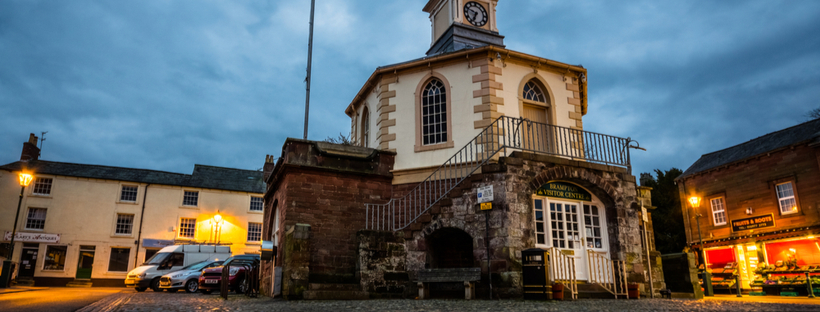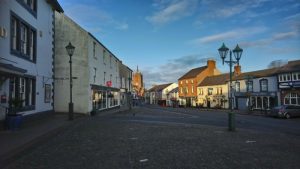
A quick guide to Brampton, Cumbria
Brampton, Cumbria is a small market town and civil parish, situated in the northeast of the county of Cumbria, in northwest England. Brampton lies about 9 miles (14 km) east of Carlisle and 2 just miles (3 km) south of the famed Hadrian’s Wall. Historically part of Cumberland, the town is located just off the A69 truck road which runs east between Carlisle and Newcastle. At the 2011 UK census, the population of Brampton was recorded as 4,627.

Main Street, Brampton. Photo Credit – H Athey/Shutterstock.com
Go to the Cumbria Business Directory
To join the Brampton Group – Click here
Brampton, A Fleeting History
The historic market town of Brampton is thought to have been first settled in the 7th century when it was established by the invading Angles. The designation ‘Braunton’, was the first written reference of a name for the settlement, not recorded until the mid-13th century. The name is thought to have been derived from the Old English ‘Brōm-tūn’, meaning “the place where broom grows”. However, by the end of the 13th century, the name ‘Brampton’, was in use.
By the 13th century, a settlement had grown up around (the surviving) Brampton Old Church, about 1.5 miles northwest of the existing town centre. In time, the entire village was forced to relocate on the whim of the local Barony, who had decided it was the ideal place for a deer park. However, the parish church stayed put, meaning that the churchgoers of Brampton were obliged to walk a mile or so to church on Sundays for the next six hundred years.
In 1252, Brampton was granted a charter by Henry III, for a weekly market and an annual fair. It duly became the trading hub for the Barony of Gilsland and the wider area of north-east Cumberland. For the next few hundred years, things in the remote north Cumberland didn’t change that much, and the townsfolk of Brampton quietly got on with their daily lives.
In 1648, the town’s original moot hall was built. During the mid-17th century, it was utilised by Oliver Cromwell’s forces as a temporary jail, housing as many as 40 prisoners. In 1688, Thomas Denton described Brampton as a ”market well stored with all sorts of corn, especially rye” and observed it was ”improved both in building and trade”. He estimated the population of the town to be 630.
From the mid-18th century onwards, Brampton began to transform from being just a market town, towards also being an industrial centre. In 1758, this process was greatly enhanced by the opening of the Military Road, which linked Carlisle with Newcastle.
In 1785, the town’s first brewery was a set-up, originally known as J. Armstong’s, the name was changed to Brampton Old Brewery, around 1910. Circa 1790, a tannery was founded, establishing the town’s long association with the leather industry. By the end of the 18th century, small scale coal mining was also underway in the area. In 1799, Brampton’s coal staith was linked by a waggonway to the Earl of Carlisle’s collieries and quarries at Tindale Fell. By 1801, the town’s population had reached 1,682, with that of the wider parish being at 2,125.
It was in the late 18th century, as the town began to prosper, that a good deal of the town centre was rebuilt. Most of the new buildings were constructed of the local red sandstone, which was quarried at the nearby Gelt Woods. By the turn of the 19th century, there were 45 pubs in Brampton, serving a population of around 3000. Not surprisingly drunkenness became a major problem in the area. Nonetheless, in 1829, a second brewery was founded in Brampton.
In 1836, Newcastle and Carlisle Railway opened, where Milton, about 2 or so miles from Brampton, was the nearest stop to the town. A short branch line took passengers by horse-drawn ‘dandy wagon’ from the Staith ( later renamed Brampton Town Station) to Milton Station. The line closed in 1890, but reopened briefly, twice between 1913 and 1923.
Throughout the 19th century, the local leather industry continued to thrive. By the mid-1800s, there were 17 businesses employing around 80 shoemakers in town. At the same time, textiles were employing around 200 people. In 1865, the Scotch Tweed Mill was opened, and by 1873, it was employing 150 people. Other manufacturing at the time, included hat making and nail making, and by the late 19th century, mineral water production.
By 1841, the town’s population had grown to 2,754, and in 1871, reached a peak of 3,557. In 1875, the Scotch Tweed Mill was destroyed by fire. Although, the mill was quickly rebuilt it failed to flourish and closed within a few years. This event marked a turning point in Brampton’s fortunes, as the town’s manufacturing base began to decline. By 1931, the town’s population had decreased to 2,526. However, it was in the 1930s, that the town began to modernise its housing stock, with the support of the Brampton Public Utility Society.
Brampton, The Modern Era
In 1951, construction began on the RAF’s Spadeadam rocket testing site at Gilsland, about 10 miles from Brampton. This brought in a large influx of skilled workers to the area. which resulted in the building of two new housing estates in Brampton. Although the flood of new arrivals was relatively short-lived, Brampton continued to grow, albeit very slowly, as a dormitory town for nearby Carlisle. By 1971, the population of the town had surpassed its previous peak, rising to 4,033.
During the 1980s, a small industrial estate was developed at Townfoot, maintaining some jobs in the town. By 2001, the town’s population had only grown by around 8% from its 1971 level.
Brampton operates one of about 500 community-based trusts in the UK. The ‘Brampton and Beyond Community Trust’ is a registered company and registered charity, which is wholly community-based, owned and led. The Trust provides some community-based services that were formerly funded by the County Council.
Getting to Brampton
By Road
It’s quite easy getting to Brampton by road. From the South, take the M6 to Junction 43, then head east for 10 miles along the A69. From Scotland, take the A74(M), which becomes the M6 at the border with England. At Junction 44 of the M6, turn left on to the A685, then head east for about 9 miles until you reach the crossroads with the A69, just to the west of Brampton. From the East, head to Newcastle, and then take the A69 and head west towards Carlisle.
By Bus
Arriva in partnership with Stagecoach operates the daily bus service between Carlisle and Newcastle. The 685 bus departs from Eldon Square Bus Station, Newcastle and ends its journey at Carlisle Bus Station and vice versa. The service runs about every hour from around 6.00 am to about 8 pm with a journey of 1 hr 50 mins to Brampton from Newcastle. The travelling time between Brampton and Carlisle is about 25 minutes.
There’s also a local bus, the ‘Border Rambler’ which travels each way between Carlisle and Laversdale, passing through a number of villages and Brampton en-route. However, the bus only runs twice per week, with a journey time of 37 mins between Brampton and Carlisle.
By Train
To get to Brampton by train, head first to either Carlisle or Newcastle, as the town is a stop on the line between the two cities. The journey time between Carlisle and Brampton is about 20 minutes; and between Newcastle and Brampton, about 1 hr 10 mins. There are 11 trains in each direction that pass-through Brampton bound for either Carlisle or Newcastle.
By Air
The nearest airport to Brampton is the newly opened Carlisle Airport. It’s only about 7 miles along the A685 and not more than a 15-minute drive. However, you can currently only fly to Carlisle from Belfast, Dublin and Southend (London). The alternative is to fly to Newcastle International Airport and then travel to Brampton via any of the above.
A Prime Sporting Event
The Brampton to Carlisle 10 Mile Road Race, which is held annually in November, is the oldest 10-mile road race in the UK. Past winners of the prestigious race include British running legends Steve Cram and Ron Hill.
Did you know?
- World-famous 19th-century author, Charles Dickens once stayed at Howard Arms on Front Street, on his travels around Britain.
- Brampton was once home to one of the world’s largest collections of memorabilia devoted to famed 19th-century author, Charles Dickens. It was amassed by the once resident Edmund S. Williamson and it became famed worldwide. Mr Williamson ended up moving, with his collection, to Toronto.
- In 1745, during the Jacobite uprising, Charles Edward Stuart, better known as ‘Bonnie Prince Charlie’, stayed overnight in the town. The next day, he summoned the Mayor of Carlisle to meet him in Brampton. During the meeting, the ‘Young Pretender’ asked the major to relinquish his control of Carlisle.
Things to see and do in Brampton!

Talkin Tarn – just 2 miles from Brampton
A few of the recommended things to see and do around Brampton are:
- Lanercost Priory – about 2.5 miles from Brampton, the well preserved ruined priory was founded in 1166 for the Augustinian Order. Ran by English Heritage, the site has lots of history as well as a recommended tea room!
- Birdoswald Roman Fort (Hadrian’s Wall) – only 5 miles from Brampton is Birdoswald Roman Fort, one of the best-preserved forts on Hadrian’s Wall. Open times are 10 am to 4 pm Sundays to Wednesdays. There is a cafe on-site as well as educational interactive games for the kids.
- Talkin Tarn – is a small glacial lake within a country park about 2 miles from Brampton. There’s a small on-site café and a range of activities are on offer, which includes rowing, sailing and archery. However, ”beware”! – local legend has it that there’s a monster pike living in the tarn.
- Moot Hall – Dating back to 1648, the present building dates to 1817, being built for Lord Carlisle. It’s also home to the tourist information centre. Open-air markets are still held around the hall on a weekly basis.
See Things to do in our Business Directory
Where to stay?
Being a small town, accommodation is obviously fairly limited in Brampton itself, but there is a decent range of places to stay a little further afield. Carlisle is probably the cheapest place to stay with the locality. A rough estimate of accommodation costs in and around Brampton are:
Guesthouse, B & B, Travel Lodge: £40 – £70
Pub, Small Hotel: £70 – £100
3 & 4 Star Hotel: £100 – £150
Luxury Holiday home: £200 – £500 (2 to 6 people sharing)
See Places to stay in our Business Directory
Editorial Credit for photos: PJ Photography/Shutterstock.com

